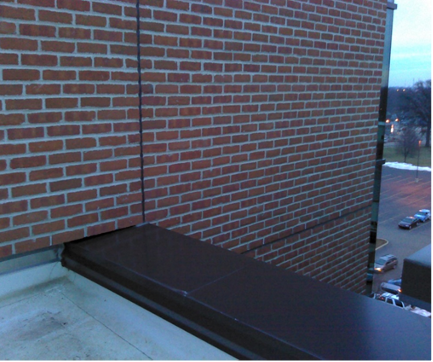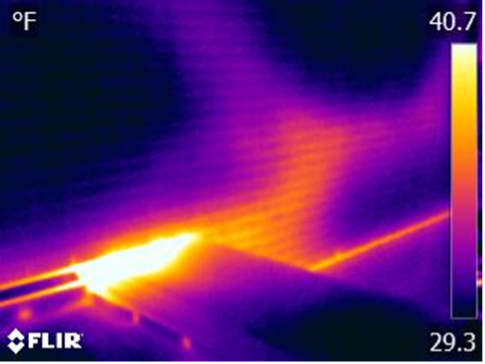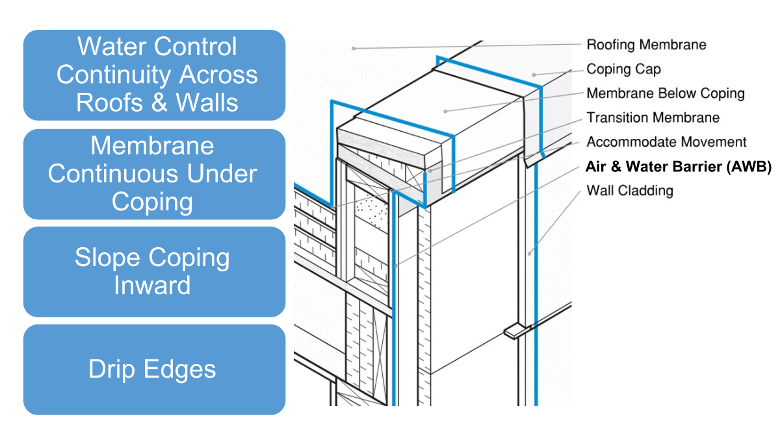Risky Business
Energy Efficiency Management
Managing energy efficiency of buildings relies upon both preventing uncontrolled air movement and resisting heat flow. Adding more insulation to the thermal control layer could seem to provide the answer to improving energy efficiency. However, simply adding more insulation to a building envelope soon reaches the point of rapidly diminishing returns. The real culprit behind poor efficiency is air movement.
Airflow through the building envelope is the most effective method of carrying heat and moisture into or out of a building. In order for air to flow in or out of a space, there needs to be a pressure differential across the boundary and an opening for the air to move through. Buildings become pressurized due to wind, stack effect, and heating, air conditioning, and ventilation (HVAC) systems. Wind exerts pressure on the building enclosure causing positive pressure on the windward side and negative pressure on the opposite side. Stack effect is caused by warm air rising, increasing pressures higher up in the building. Any discontinuities in the air control layer, no matter how small, will provide the opening for air along with heat and moisture vapor to move through the enclosure.

Image courtesy of SmithGroup
Airglow through the building envelope is the most effective method of carrying heat and moisture into or out of a building as shown in the FLIR image of a rising wall detail.

Image courtesy of SmithGroup
Air leakage has been identified as a significant, quantifiable contributor to poor building energy efficiency. According to “The Hidden Science of High Performing Building Assemblies,” Environmental Building News November 2012, air infiltration and exfiltration make up an estimated 25-40 percent of total heat loss from a building in a cold climate. Buildings in hot climates are not immune to the impacts of air leakage. In a hot climate, air leakage makes up 10-15 percent of total heat gain, increasing the energy costs to cool the interior. Losing up to one-third of conditioned air to uncontrolled airflow has a weighty impact on the operation of a building and is a significant preventable cost. Moist, hot air entering the conditioned space not only requires extra energy to cool, it also must be dehumidified. If it is not dehumidified, humid air can condense when it contacts a cooler surface, leading to damaging water buildup. These increases in energy usage are why the International Energy Conservation Code (IECC) has required the use of air barriers in building enclosures since 2012.
Control layers that address airflow not only create energy savings but also help to mitigate moisture accumulation. This interrelationship of air and moisture, and how they are controlled, leads to the importance of the interactivity of control layers.
Working Together = Success!
Given the interwoven concerns of managing air and moisture, control layers are better viewed as interconnected layers and assemblies and not just a single product or material. The enclosure is better defined as a combination of materials assembled and joined together in a system, providing a continuous barrier to water penetration, air leakage, moisture vapor intrusion and thermal movement through the building envelope.
The relative importance of each control layer is based upon the magnitude of impact it has on the performance of the building enclosure. The liquid water control layer must be addressed first. Uncontrolled liquid water in a building is extremely deleterious and failures here render other control strategies less consequential. Second in importance is the air control layer, due to its interrelationship with heat and moisture. The thermal control layer is next, as it regulates where condensation from leaked air could potentially occur. Finally, water vapor management strategies provide the final layer protection.
Any of these barriers’ effectiveness can be greatly reduced by discontinuities, even small ones. These openings can be caused by poor design, damage from other trades, improper sealing and flashing, mechanical forces, aging, and other forms of degradation. Thankfully, there are ways to avoid these discontinuities and set up a project for success.
Examining Control Layers in Action
Key Point: Each control layer serves a purpose and must be located properly to perform.
The perfect wall is an environmental separator—it has to keep the outside out and the inside in, writes Joseph Lstiburek, Principal Ph.D., P.Eng., ASHRAE Fellow, at Building Science Corporation. “In order to do this the wall assembly has to control rain, air, vapor, and heat. The best place for the control layers is to locate them on the outside of the structure in order to protect the structure. And since most of the bad stuff comes from outside the best place to control the bad stuff is on the outside of the structure before it gets to the structure.”1
How can the architect and construction team make this work? Is there a right and wrong order for control layers? As Lstiburek points out, “If you can’t keep the rain out, don't waste your time on the air. If you can’t keep the air out, don't waste your time on the vapor.”2 The first step is to ensure the layers are continuous. Any breaks in the system lead to trouble. While flat parts of the building enclosure can be designed relatively easily with a line for each control layer, managing the control layers becomes increasingly complicated at foundation, wall, and roof systems interfaces and as details, like parapets, are added.
Looking at a detail such as a parapet will help to illustrate the best practices for controlling each of these elements.
Water Control Principles
Preventing water from infiltrating the building enclosure at any point is of first concern when thinking about the building enclosure. Water control strategies should be planned in the way water flows: starting at the top, down to the bottom of the structure. The phrase “Slope to drain and then drip” also offers a good strategy summary. The water control layer must be continuous across all six sides of the building enclosure. The primary water control layer is the exterior surface of the structure, with a potential secondary water resistive barrier further into the assembly providing a final stopping point. Any interfaces of materials and assemblies must be lapped with the top material coming over a lower material. This lapping prevents a potential lip where water can sit and eventually work its way into the building. All membranes and flashing should be continuous under coping, with coping sloped inward toward roof drains. Drip edges on the outside of coping as well as on all other horizontal surfaces are vital to sending bulk water out and away from the building and preventing capillary action from bringing water back into the enclosure.

Image courtesy of GAF
Water control principles at the roof-wall interface.
Air Control Principles
The goal of an air control layer is the prevention of uncontrolled air movement. There are three main types of air movement through a building enclosure assembly: infiltration, exfiltration, and intrusion.
The most common forms of uncontrolled air leakage are infiltration and exfiltration, where outside air travels into or out of the building respectively. Infiltration and exfiltration are what is measured through air leakage testing. The IECC sets limits on these measurements when whole building airtightness testing is required. Air intrusion occurs when air within the building travels from conditioned space into unconditioned areas within the building enclosure, such as into the roof assembly or floor line space. It moves through the space, and then back into the conditioned part of the building. While this movement is not classified by the building or energy code as air leakage, it can still cause issues due to the heat and moisture that it brings into areas of the building that may not be designed to manage it. For example, in a cold climate, interior air that travels into the roof assembly can cool and create the potential for condensation. Condensation on the roof deck can lead to mold and decay.









